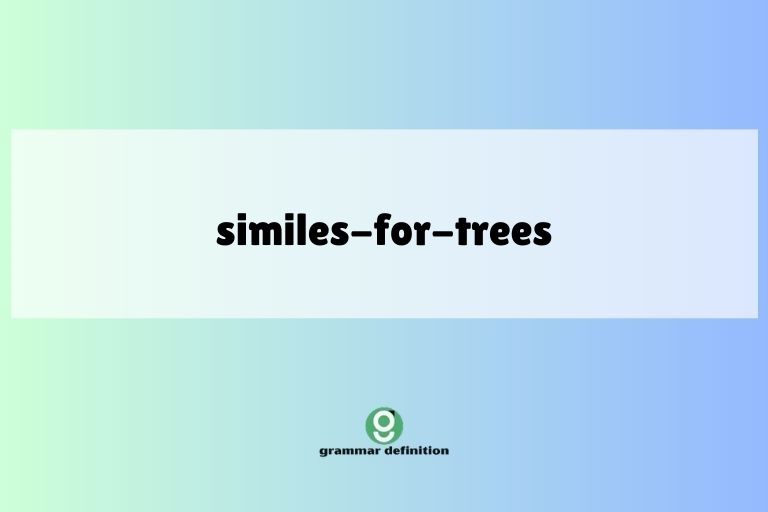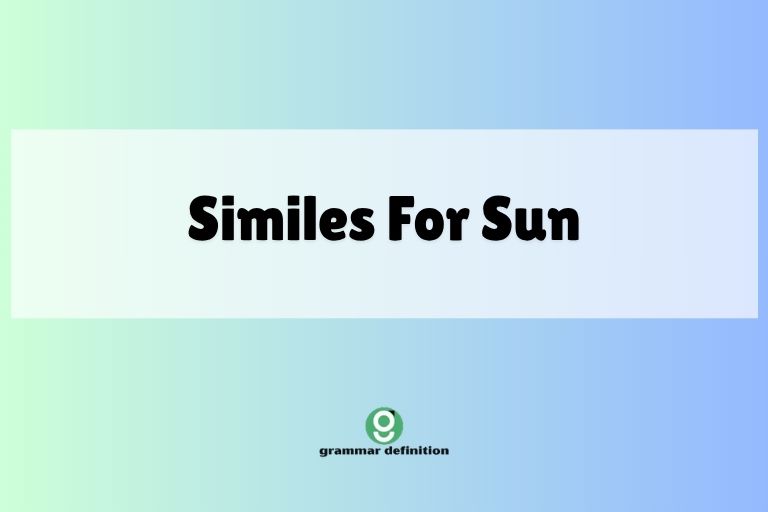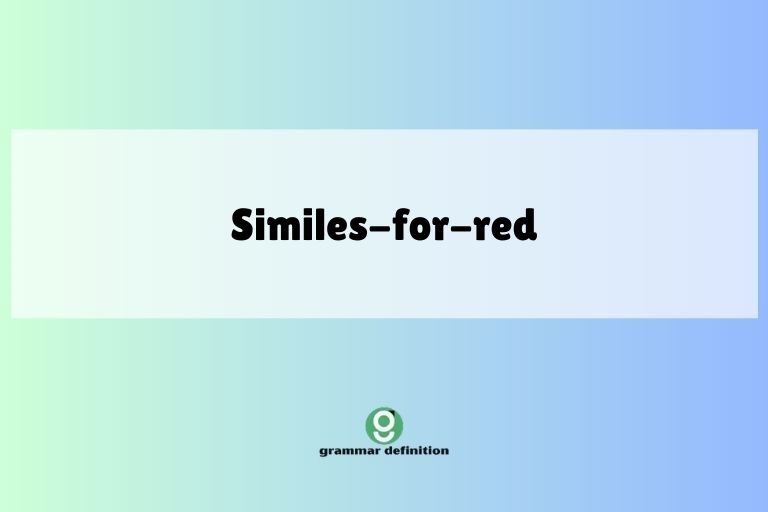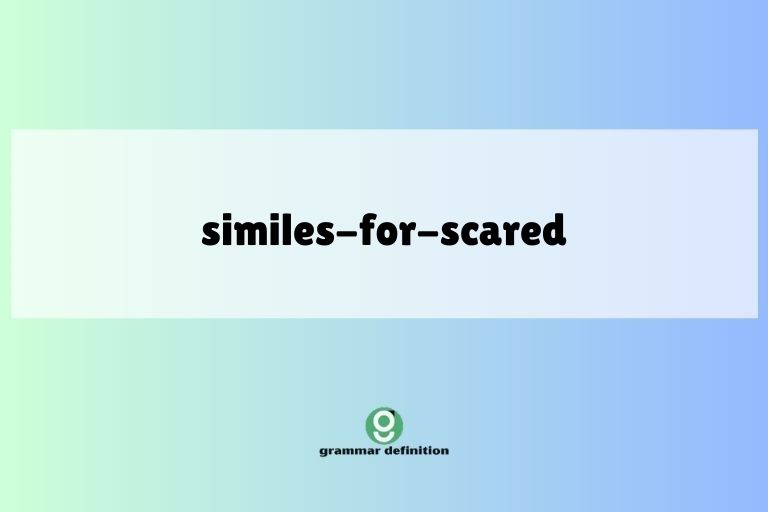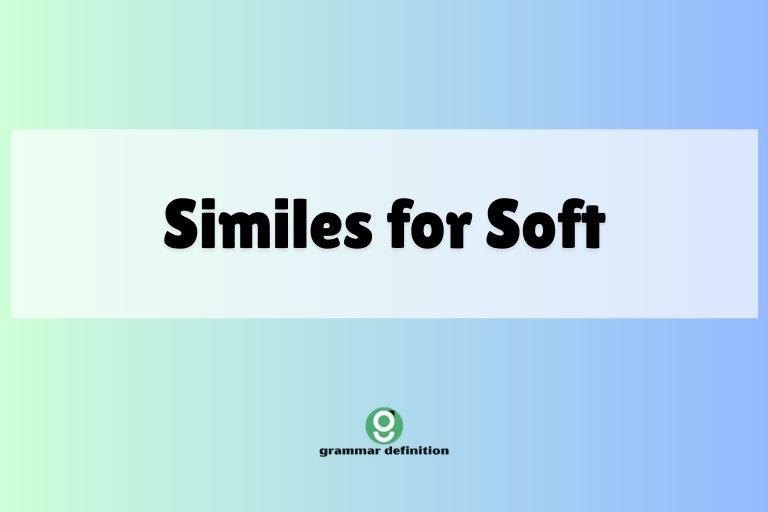Autumn Similes: Capturing Fall with Figurative Language
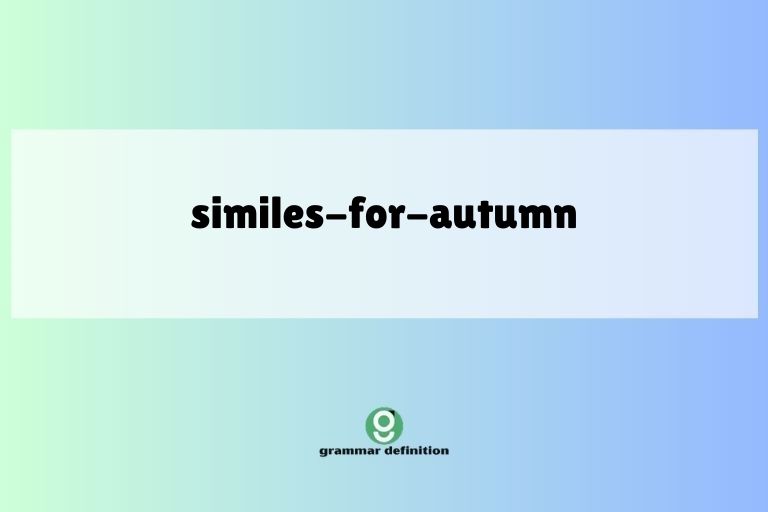
Autumn, a season of vibrant colors and crisp air, provides rich inspiration for writers and poets. Understanding and using similes effectively allows us to paint vivid pictures with words, enhancing our descriptions and making our writing more engaging.
This article offers a comprehensive guide to using similes to describe autumn, suitable for students, writers, and anyone interested in improving their English language skills. By exploring various examples and practice exercises, you’ll learn how to craft compelling similes that capture the essence of fall.
Table of Contents
- Definition of Simile
- Structural Elements of a Simile
- Types of Similes
- Examples of Similes for Autumn
- Usage Rules for Similes
- Common Mistakes with Similes
- Practice Exercises
- Advanced Topics in Similes
- Frequently Asked Questions
- Conclusion
Definition of Simile
A simile is a figure of speech that directly compares two different things using the words “like” or “as.” Similes are used to make descriptions more vivid and relatable, allowing writers to draw connections between dissimilar objects or concepts. They help readers understand and visualize ideas more effectively by associating them with something familiar. Unlike metaphors, which imply a direct equivalence, similes acknowledge the comparison with explicit linking words.
The primary function of a simile is to enhance descriptive writing. By comparing something to something else, we can highlight specific qualities or characteristics.
Similes can be used in various contexts, from poetry and literature to everyday conversation. They add depth and color to our language, making it more engaging and expressive.
Understanding similes is crucial for both comprehending and creating effective writing.
Structural Elements of a Simile
A simile typically consists of three main elements: the subject (the thing being described), the linking word (usually “like” or “as”), and the object of comparison (the thing the subject is being compared to). Understanding these elements is essential for constructing grammatically correct and effective similes.
- Subject: This is the noun or noun phrase that is being described. For example, “The leaves” in “The leaves are like gold.”
- Linking Word: This word connects the subject and the object of comparison. The most common linking words are “like” and “as.” For example, “like” in “The wind is like a whisper” or “as” in “The sky is as gray as lead.”
- Object of Comparison: This is the noun or noun phrase that the subject is being compared to. For example, “a whisper” in “The wind is like a whisper.”
The structure of a simile can be flexible, but the key is to ensure that the comparison is clear and logical. The object of comparison should share a common characteristic with the subject, allowing the reader to understand the intended meaning.
Without a clear connection, the simile may be confusing or ineffective. For instance, saying “The leaves are like cars” doesn’t make much sense unless you specify a shared characteristic, such as “The leaves are like cars, scattered across the road.”
Types of Similes
Similes can be categorized based on the type of comparison they make. While there aren’t strict, universally defined types, we can broadly classify them based on the aspect being emphasized or the effect they create.
Here are a few common categories:
- Descriptive Similes: These similes focus on physical characteristics or qualities. They aim to create a vivid image in the reader’s mind by comparing the subject to something with similar attributes.
- Emotional Similes: These similes convey feelings or emotions by associating the subject with something that evokes a similar emotional response.
- Action Similes: These similes describe actions or behaviors by comparing them to other actions or behaviors. They often use verbs to emphasize the similarity.
- Exaggerated Similes (Hyperbolic Similes): These similes use exaggeration to emphasize a point, often for humorous effect.
Understanding these categories can help you choose the most appropriate type of simile for your writing. By considering the specific effect you want to achieve, you can craft similes that are both accurate and impactful.
The key is to select an object of comparison that effectively highlights the desired aspect of the subject.
Examples of Similes for Autumn
Autumn provides a plethora of sensory experiences that lend themselves beautifully to similes. The following sections offer a range of examples categorized by different aspects of the season.
Describing Autumn Colors
Autumn is renowned for its vibrant colors. Similes can effectively capture the beauty of the changing leaves and the overall autumnal landscape.
Using colors like gold, crimson, and russet as the basis for comparison can create striking imagery.
The table below provides various examples of similes used to describe the colors of autumn.
| Simile | Explanation |
|---|---|
| The leaves are like a painter’s palette, splashed with every shade of warmth. | This simile compares the variety of leaf colors to a painter’s palette, emphasizing the abundance of warm hues. |
| The maple leaves turned as red as rubies in the afternoon sun. | This simile uses “rubies” to describe the intensity and brilliance of the red maple leaves. |
| The oak leaves were the color of aged bronze, like ancient coins glinting in the light. | This simile compares the color of oak leaves to aged bronze, suggesting a sense of history and value. |
| The forest canopy was as golden as a king’s treasure. | This simile uses “a king’s treasure” to emphasize the richness and preciousness of the golden leaves. |
| The birch trees stood like slender dancers, their leaves a vibrant yellow. | This simile compares the birch trees to dancers, highlighting their graceful form and the bright yellow color of their leaves. |
| The autumn sunset was as fiery as a dragon’s breath. | This simile uses “dragon’s breath” to emphasize the intense, burning colors of the sunset. |
| The crimson leaves fell like drops of blood onto the forest floor. | This simile uses “drops of blood” to create a dramatic and slightly melancholic image of falling crimson leaves. |
| The golden aspen leaves shimmered like a thousand tiny suns. | This simile compares the shimmering aspen leaves to “a thousand tiny suns,” highlighting their brightness and sparkle. |
| The brown leaves crinkled underfoot, like ancient parchment. | This simile compares the sound and texture of the leaves to old parchment, suggesting age and history. |
| The pumpkins in the field glowed orange, like beacons in the twilight. | This simile uses “beacons” to emphasize the bright, eye-catching color of the pumpkins against the dimming light. |
| The hillside was as ablaze with color as a painter’s masterpiece. | This simile uses a “painter’s masterpiece” to convey the stunning array of colors on the hillside. |
| The orchard’s apples hung like jewels, ruby red and emerald green. | This simile compares the apples to jewels, emphasizing their vibrant colors and precious appearance. |
| The fields were as tawny as a lion’s mane, ready for the harvest. | This simile uses “a lion’s mane” to describe the color of the fields, hinting at strength and abundance. |
| The bittersweet vines climbed the fences like ribbons of fire. | This simile compares the bittersweet vines to “ribbons of fire,” emphasizing their vibrant orange and red hues. |
| The amber leaves drifted down like golden rain. | This simile compares the falling leaves to “golden rain,” creating a sense of gentle abundance. |
| The mountainside was as colorful as a woven tapestry. | This simile uses a “woven tapestry” to convey the complex and intricate patterns of color on the mountainside. |
| The sumac bushes burned red, like torches along the roadside. | This simile compares the sumac bushes to “torches,” emphasizing their bright red color and upright form. |
| The corn stalks stood like golden soldiers in the field. | This simile compares the corn stalks to “golden soldiers,” highlighting their height and uniform color. |
| The ivy turned scarlet, as vibrant as a cardinal’s feathers. | This simile uses “a cardinal’s feathers” to describe the intense red color of the ivy. |
| The forest floor was like a patchwork quilt of fallen leaves. | This simile compares the scattered leaves on the ground to a quilt, emphasizing the variety of colors and textures. |
| The changing leaves were as bright as stained glass windows. | This simile uses “stained glass windows” to convey the luminous and vibrant colors of the leaves. |
| The autumn leaves cascaded down like a waterfall of colors. | This simile compares the falling leaves to a waterfall, emphasizing the abundance and flow of colors. |
| The sugar maple leaves glowed like embers in the late afternoon sun. | This simile uses “embers” to describe the warm, glowing color of the sugar maple leaves. |
| The colors of the turning leaves were as varied as the gems in a treasure chest. | This simile compares the variety of leaf colors to the diverse gems in a treasure chest, emphasizing their richness and beauty. |
Describing Autumn Weather
Autumn weather is often characterized by crisp air, cool breezes, and occasional storms. Similes can effectively capture these elements, conveying the feeling of the season.
The following table offers examples of similes used to describe autumn weather.
| Simile | Explanation |
|---|---|
| The autumn air was as crisp as a freshly picked apple. | This simile uses “a freshly picked apple” to convey the refreshing and invigorating quality of the autumn air. |
| The wind howled like a wolf, rattling the windows and shaking the trees. | This simile compares the sound of the wind to a wolf’s howl, emphasizing its intensity and wildness. |
| The rain fell as cold as ice upon the barren fields. | This simile uses “ice” to describe the chilling temperature of the rain. |
| The fog hung over the valley like a shroud, obscuring everything from view. | This simile compares the fog to a shroud, creating a sense of mystery and foreboding. |
| The sun shone as weakly as a dying ember, casting long shadows across the land. | This simile uses “a dying ember” to emphasize the diminished strength of the autumn sun. |
| The first frost glittered like diamonds on the grass. | This simile uses “diamonds” to describe the sparkling appearance of the frost. |
| The clouds drifted across the sky like ships on a gray sea. | This simile compares the movement of the clouds to ships sailing on a sea, emphasizing their slow and steady pace. |
| The air smelled as sweet as cinnamon and spice. | This simile uses “cinnamon and spice” to evoke the warm and comforting scents of autumn. |
| The morning dew clung to the spiderwebs like tiny pearls. | This simile compares the dew drops to pearls, highlighting their delicate and precious appearance. |
| The sky was as gray as a battleship, promising rain. | This simile uses “a battleship” to describe the dull, heavy color of the sky, foreshadowing the arrival of rain. |
| The temperature dropped as suddenly as a stone falling from a cliff. | This simile compares the sudden drop in temperature to a stone falling, emphasizing its abruptness. |
| The autumn breeze whispered through the trees like a secret. | This simile uses “a secret” to convey the gentle and mysterious sound of the breeze. |
| The distant thunder rumbled like a sleeping giant. | This simile compares the sound of thunder to a “sleeping giant,” hinting at its power and potential. |
| The leaves rustled like whispers in the wind. | This simile compares the sound of rustling leaves to whispers, creating a sense of quiet communication. |
| The twilight descended like a curtain, dimming the world. | This simile compares the twilight to a curtain, emphasizing its gradual and enveloping effect. |
| The pond was as still as glass, reflecting the autumn colors. | This simile uses “glass” to describe the smoothness and reflective quality of the pond. |
| The frost covered the fields like a blanket of snow. | This simile compares the frost to a “blanket of snow,” emphasizing its covering and whitening effect. |
| The wind cut through clothing like a knife. | This simile compares the wind’s sharpness to a knife, emphasizing its penetrating cold. |
| The harvest moon shone as brightly as a spotlight. | This simile uses “a spotlight” to highlight the moon’s intense brightness. |
| The air was as heavy with moisture as a wet sponge. | This simile compares the air’s humidity to a wet sponge, emphasizing its saturation. |
| The clouds gathered like worried thoughts. | This simile compares gathering clouds to worried thoughts, creating a sense of anxiety and impending change. |
| The storm raged like an angry beast. | This simile compares the storm’s intensity to an angry beast, emphasizing its ferocity. |
| The sun peeked through the clouds like a shy child. | This simile compares the sun’s appearance to a shy child, creating a sense of gentleness and timidity. |
| The fog rolled in like a silent ocean. | This simile compares the fog’s movement and vastness to a silent ocean, emphasizing its enveloping presence. |
| The first snowflakes fell as gently as feathers. | This simile uses “feathers” to describe the soft and light descent of the first snowflakes. |
Describing Autumn Nature
Beyond colors and weather, autumn nature encompasses a variety of elements, including falling leaves, migrating birds, and harvested crops. Similes can bring these natural phenomena to life.
The table below offers examples of similes used to describe various aspects of autumn nature.
| Simile | Explanation |
|---|---|
| The falling leaves danced like ballerinas in the wind. | This simile compares the movement of the leaves to ballerinas, emphasizing their grace and fluidity. |
| The squirrels scurried about like busy little merchants, gathering nuts for the winter. | This simile compares the squirrels to busy merchants, highlighting their industriousness. |
| The pumpkins sat in the field like giant orange orbs. | This simile uses “giant orange orbs” to describe the shape and color of the pumpkins. |
| The bare trees stood like skeletons against the winter sky. | This simile compares the trees to skeletons, emphasizing their stark and lifeless appearance. |
| The migrating geese flew in formation like a feathered arrow pointing south. | This simile compares the geese formation to an arrow, emphasizing their direction and precision. |
| The corn stalks stood like teepees in the abandoned fields. | This simile compares the corn stalks to teepees, highlighting their shape and arrangement. |
| The apples hung heavy on the branches like ornaments on a Christmas tree. | This simile uses “ornaments” to emphasize the abundance and decorative appearance of the apples. |
| The spiderwebs glistened like lace, strung between the branches. | This simile compares the spiderwebs to lace, highlighting their delicate and intricate structure. |
| The dried leaves crunched underfoot like potato chips. | This simile compares the sound of the leaves to potato chips, emphasizing their crispness. |
| The pumpkins gleamed like jack-o’-lanterns, even in daylight. | This simile compares the pumpkins to jack-o’-lanterns, emphasizing their bright orange color. |
| The last wildflowers bloomed like stubborn reminders of summer. | This simile uses “stubborn reminders” to convey the persistence of the wildflowers. |
| The bare branches reached towards the sky like pleading arms. | This simile compares the branches to pleading arms, creating a sense of yearning and supplication. |
| The harvested fields lay fallow like a sleeping giant. | This simile compares the fields to a “sleeping giant,” hinting at their potential for future growth. |
| The seed pods rattled like maracas in the breeze. | This simile compares the sound of the seed pods to maracas, emphasizing their rhythmic sound. |
| The birds gathered on the power lines like notes on a musical staff. | This simile compares the birds to notes on a staff, highlighting their arrangement and collective presence. |
| The mushrooms sprouted like umbrellas after the rain. | This simile compares the mushrooms to umbrellas, emphasizing their shape and sudden appearance. |
| The cattails stood like sentinels along the edge of the pond. | This simile compares the cattails to sentinels, highlighting their upright form and watchful presence. |
| The berries shone like tiny jewels on the bushes. | This simile compares the berries to jewels, emphasizing their small size and bright colors. |
| The fallen apples lay on the ground like forgotten treasures. | This simile uses “forgotten treasures” to convey the abundance and overlooked value of the apples. |
| The sunflower heads drooped like tired faces. | This simile compares the sunflowers to tired faces, emphasizing their downward tilt. |
| The leaves floated on the pond like miniature boats. | This simile compares the leaves to miniature boats, highlighting their buoyancy and movement on the water. |
| The spiderwebs stretched across the path like delicate curtains. | This simile compares the spiderwebs to delicate curtains, emphasizing their thinness and obstructing presence. |
| The pumpkins clustered together like a family gathering. | This simile compares the pumpkins to a family gathering, creating a sense of warmth and togetherness. |
| The withered vines clung to the trellis like desperate hands. | This simile compares the vines to desperate hands, emphasizing their clinging and decaying state. |
| The acorns fell from the trees like tiny bombs. | This simile compares the falling acorns to tiny bombs, emphasizing their sudden impact. |
Describing Autumn Feelings
Autumn often evokes a range of emotions, from nostalgia to melancholy. Similes can be used to capture these feelings, adding depth and emotional resonance to your writing.
The following table offers examples of similes used to describe the feelings associated with autumn.
| Simile | Explanation |
|---|---|
| The nostalgia of autumn settled over me like a warm blanket. | This simile compares the feeling of nostalgia to a warm blanket, emphasizing its comforting and enveloping quality. |
| The melancholy of the season hung in the air like a heavy cloud. | This simile compares the melancholy to a heavy cloud, emphasizing its oppressive and lingering presence. |
| The anticipation of winter grew like a seed, slowly taking root in my mind. | This simile compares the anticipation of winter to a seed, emphasizing its gradual and persistent growth. |
| The memories of past autumns flooded back like a forgotten song. | This simile compares the memories to a forgotten song, emphasizing their familiarity and emotional resonance. |
| The feeling of change was as palpable as the crisp air on my skin. | This simile compares the feeling of change to the sensation of crisp air, emphasizing its immediate and noticeable impact. |
| The silence of the woods was as deep as a well. | This simile compares the silence to a well, emphasizing its profoundness and depth. |
| The comfort of a warm fire felt like a hug on a cold day. | This simile compares the comfort of a fire to a hug, emphasizing its warmth and reassurance. |
| The sense of loss was as sharp as the first frost. | This simile compares the sense of loss to the first frost, emphasizing its biting and painful quality. |
| The joy of the harvest felt like a reward for hard work. | This simile compares the joy of the harvest to a reward, emphasizing its deservedness and satisfaction. |
| The anticipation of the holidays bubbled up like champagne. | This simile compares the anticipation to champagne, emphasizing its effervescent and celebratory quality. |
| The quiet beauty of autumn was as soothing as a lullaby. | This simile compares the beauty of autumn to a lullaby, emphasizing its calming and peaceful effect. |
| The chill in the air felt like a warning of what was to come. | This simile compares the chill to a warning, emphasizing its foreboding and cautionary nature. |
| The longing for summer lingered like a faded photograph. | This simile compares the longing to a photograph, emphasizing its past presence and diminishing intensity. |
| The peace of the season settled like a gentle snow. | This simile compares the peace to a gentle snow, emphasizing its soft and enveloping effect. |
| The solitude of the woods was as comforting as an old friend. | This simile compares the solitude to an old friend, emphasizing its familiarity and reassurance. |
| The excitement of Halloween crackled like electricity in the air. | This simile compares the excitement to electricity, emphasizing its energy and intensity. |
| The gratitude for the harvest swelled like a rising tide. | This simile compares the gratitude to a rising tide, emphasizing its abundance and overwhelming feeling. |
| The sense of closure felt like the last page of a good book. | This simile compares the sense of closure to the end of a book, emphasizing its completion and satisfaction. |
| The beauty of the changing leaves was as breathtaking as a mountain vista. | This simile compares the beauty of the leaves to a mountain vista, emphasizing its grandeur and awe-inspiring quality. |
| The feeling of autumn’s embrace was as welcoming as a warm hearth. | This simile compares the feeling to a warm hearth, emphasizing its comfort and invitation. |
| The stillness of the morning was as profound as a meditation. | This simile compares the stillness to meditation, emphasizing its depth and tranquility. |
| The reflection on the past year felt like turning the pages of an old diary. | This simile compares reflection to reading a diary, highlighting the personal and introspective nature of the process. |
| The warmth of a shared meal felt like a celebration of togetherness. | This simile compares the warmth to celebration, emphasizing its joy and communal aspect. |
| The anticipation of the coming holidays felt like a secret whispered in the wind. | This simile compares anticipation to a whispered secret, emphasizing its excitement and mystery. |
| The quiet joy of a crisp autumn day was as simple as a child’s laughter. | This simile compares the joy to a child’s laughter, emphasizing its purity and simplicity. |
Usage Rules for Similes
While similes offer creative freedom, there are certain rules to follow to ensure clarity and effectiveness. These rules primarily relate to the logic and appropriateness of the comparison.
- Clarity: The comparison should be clear and easily understandable. The reader should be able to grasp the connection between the subject and the object of comparison.
- Relevance: The object of comparison should share a relevant characteristic with the subject. The similarity should be meaningful and contribute to the overall description.
- Originality: While common similes can be effective, strive for originality to make your writing stand out. Avoid clichés and overused comparisons.
- Context: The simile should be appropriate for the context of the writing. Consider the tone, audience, and overall purpose of the piece.
Exceptions to these rules are rare, but sometimes breaking a rule can be effective if done intentionally and for a specific purpose. For example, an illogical simile might be used for humorous effect or to create a surreal image.
However, in most cases, adhering to the rules will result in a more effective and impactful simile.
Common Mistakes with Similes
Several common mistakes can weaken or invalidate a simile. Being aware of these pitfalls can help you avoid them and improve your writing.
| Incorrect | Correct | Explanation |
|---|---|---|
| The leaves are like good. | The leaves are like gold. | This mistake involves a simple typo, changing the meaning of the simile entirely. |
| The wind is as cold like ice. | The wind is as cold as ice. | This example incorrectly uses both “as” and “like” in the same simile. Only one is needed. |
| The leaves are like air. | The leaves are like colorful confetti. | This simile is ineffective because it lacks a clear connection. Air doesn’t provide a meaningful comparison. |
| The autumn is as a season. | Autumn is as beautiful as a painting. | This incorrect simile uses “a” unnecessarily. The comparison also lacks specificity. |
| The sky was gray, similar to rain. | The sky was as gray as rain clouds. | Using “similar to” is not a simile. “As” or “like” are required for a simile. |
Avoiding these common mistakes will strengthen your similes and make your writing more effective. Always double-check your work to ensure that your comparisons are clear, relevant, and grammatically correct.
Practice Exercises
The best way to master similes is through practice. The following exercises will help you develop your skills in creating and identifying effective similes.
Exercise 1: Complete the Simile
Complete the following similes with an appropriate object of comparison.
| Question | Answer |
|---|---|
| The autumn air is as crisp as _____. | The autumn air is as crisp as a freshly picked apple. |
| The leaves fell like _____. | The leaves fell like golden rain. |
| The pumpkins sat in the field like _____. | The pumpkins sat in the field like giant orange orbs. |
| The wind howled like _____. | The wind howled like a wolf. |
| The fog hung over the valley like _____. | The fog hung over the valley like a shroud. |
| The berries shone like _____. | The berries shone like tiny jewels. |
| The bare trees stood like _____. | The bare trees stood like skeletons. |
| The dried leaves crunched underfoot like _____. | The dried leaves crunched underfoot like potato chips. |
| The silence of the woods was as deep as _____. | The silence of the woods was as deep as a well. |
| The nostalgia of autumn settled over me like _____. | The nostalgia of autumn settled over me like a warm blanket. |
Exercise 2: Identify the Simile
Identify the simile in each of the following sentences.
| Question | Answer |
|---|---|
| The autumn sky was a brilliant blue. | No simile present. |
| The leaves were like flames dancing in the wind. | The leaves were like flames dancing in the wind. |
| Autumn is a beautiful time of year. | No simile present. |
| The trees stood tall and proud. | No simile present. |
| The air smelled as sweet as cinnamon. | The air smelled as sweet as cinnamon. |
| The sun shone brightly on the fields. | No simile present. |
| The pumpkins were orange and round. | No simile present. |
| The wind whispered through the trees. | No simile present (this is personification). |
| The clouds drifted like boats on the ocean. | The clouds drifted like boats on the ocean. |
| The apples were red and juicy. | No simile present. |
Exercise 3: Create Your Own Similes
Write your own similes to describe the following aspects of autumn.
| Prompt | Example Answer |
|---|---|
| Describe the sound of the wind. | The wind sounded like a mournful sigh. |
| Describe the color of the sky. | The sky was as blue as a robin’s egg. |
| Describe the feeling of walking through fallen leaves. | Walking through fallen leaves felt like walking on a soft, crackling carpet. |
| Describe the taste of a pumpkin spice latte. | A pumpkin spice latte tastes like autumn in a cup. |
| Describe the sight of a field of pumpkins. | The field of pumpkins looked like a sea of orange. |
| Describe the smell of burning leaves. | The smell of burning leaves was like a nostalgic memory. |
| Describe the feeling of a cool autumn evening. | A cool autumn evening felt like a gentle, peaceful hug. |
| Describe the look of bare branches against the sky. | Bare branches against the sky looked like nature’s calligraphy. |
| Describe the taste of a freshly picked apple. | A freshly picked apple tastes like crisp, sweet sunshine. |
| Describe the feeling of wearing a warm sweater on a cold day. | Wearing a warm sweater felt like a comforting embrace. |
Advanced Topics in Similes
For advanced learners, there are several nuanced aspects of similes to explore. These include extended similes, implied similes, and the use of similes in different genres.
- Extended Similes: These are similes that are developed over several sentences or even paragraphs. They provide a more detailed and elaborate comparison, allowing for a richer and more nuanced description.
- Implied Similes: In an implied simile, the linking word (“like” or “as”) is omitted, but the comparison is still evident. This can create a more subtle and sophisticated effect.
- Similes in Different Genres: The use of similes can vary depending on the genre of writing. For example, similes in poetry may be more lyrical and evocative, while similes in scientific writing may be more precise and factual.
Exploring these advanced topics can help you further refine your understanding and use of similes, allowing you to create more sophisticated and impactful writing.
Frequently Asked Questions
Here are some frequently asked questions about similes, with detailed answers to help clarify any remaining points.
- What is the difference between a simile
and a metaphor?
A simile is a comparison using “like” or “as,” while a metaphor implies a direct equivalence without these words. For example, “The leaves are like gold” (simile) vs. “The leaves are gold” (metaphor).
- Can a simile be too cliché?
Yes, overused similes can make your writing seem unoriginal. Try to come up with fresh, creative comparisons.
- How can I make my similes more effective?
Choose objects of comparison that are vivid, relevant, and original. Ensure the connection between the subject and object is clear and meaningful.
- Is it okay to use similes in formal writing?
Yes, similes can be used in formal writing, but they should be used sparingly and with careful consideration of the tone and audience. Avoid overly informal or colloquial comparisons.
- How do I avoid mixed metaphors and similes?
Ensure that the elements you are comparing are consistent and logical. Avoid combining unrelated images or ideas.
Conclusion
Mastering the art of using similes can significantly enhance your descriptive writing, especially when capturing the essence of autumn. By understanding the structural elements, types, and usage rules of similes, you can create vivid and engaging comparisons that bring your writing to life.
Remember to practice regularly, avoid common mistakes, and strive for originality in your comparisons. With these tools, you’ll be well-equipped to paint a beautiful and evocative picture of autumn with words.

